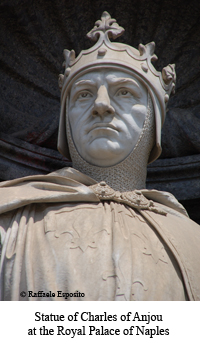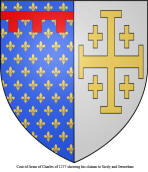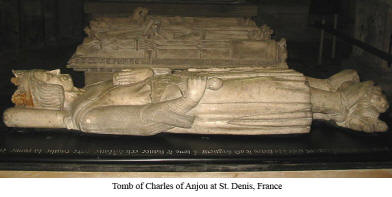The man whom Urban IV chose to rid the papacy of Manfred has
been portrayed as either the consummate medieval statesman or the devil
incarnate, depending on the nationality of the author. Charles of Anjou
has been vilified by German authors for executing the young Conradin
in 1266, while Italian authors have portrayed him as a cruel oppressor who
was sucking the life out of the Kingdom of Sicily. The French authors in
defense of Charles point out that he was in fact an efficient and
beneficent ruler, if somewhat ambitious. They argue that Charles brought
efficient government to the areas he ruled and administered justice in an
impartial and exemplary manner. What does appear clear, from his handling
of his estates in France to his later schemes with regards to the
Byzantine Empire, is that Charles was extremely ambitious and willing to
take advantage of any situation that presented itself. While there is no
 doubt he was a pious man, he saw himself more as an independent instrument
of God and he was not one to let himself be manipulated by a pope. He was
also a meticulous planner and a supreme organizer. However, this penchant
towards organizing his holdings so that he could extract the maximum
benefit from them did not endear him to his subjects.
doubt he was a pious man, he saw himself more as an independent instrument
of God and he was not one to let himself be manipulated by a pope. He was
also a meticulous planner and a supreme organizer. However, this penchant
towards organizing his holdings so that he could extract the maximum
benefit from them did not endear him to his subjects.
Charles was born in 1227 as the youngest brother of Louis IX and is described as having grown up in rather loveless surroundings at the court. However, Charles also received an outstanding education and, being at the center of the Capetian court, obtained firsthand experience in governmental affairs. Moreover, his family did arrange for the young Charles to come into possession of some of the most important territories in France, either through inheritance or marriage. At the age of twenty, he was enfeoffed with the important counties of Anjou and Maine. More importantly, by way of marriage to Beatrice of Provence, he had come into possession of the rich lands of Provence in 1246, and he moved swiftly to exert his command over the region. It is here that a pattern of control appears that Charles would use again in Sicily with disastrous results.The coat of arms to the left shows his pretensions. The left half is the coat of arms for Sicily and the right half or the Kingdom of Jerusalem, which he bought in 1277.
 Almost immediately, Charles began to place French lawyers and
administrators in the offices of the county and to demand his rights as
overlord of the region. It was not that Charles was asking for rights and
dues that were not legally his, but the Provençals were not accustomed to
the rather efficient manner in which the Angevin officials went about
enforcing them. In 1251 Charles was forced to put down a revolt at Arles,
Avignon, and Marseilles and had to return in 1256 to suppress another
uprising at Marseilles when he finally stripped the city of its political
power and replaced the city officials with his own. His problems there
would not end until he crushed further conspiracies and revolts in 1262
and 1263. It was at this time that he began to turn the city into a major
naval base. While the Angevin administration of the city would generally
prove beneficial until the War of the Sicilian Vespers, the causes for the
initial revolt seem to have escaped Charles. He simply did not appear realize
that it had been the manner in which he had
imposed his government on the populace that had triggered the revolts,
not the government itself. While Charles had been able to suppress the
Provençal revolts, he would not have the same good fortune in dealing
with the Sicilians.
Almost immediately, Charles began to place French lawyers and
administrators in the offices of the county and to demand his rights as
overlord of the region. It was not that Charles was asking for rights and
dues that were not legally his, but the Provençals were not accustomed to
the rather efficient manner in which the Angevin officials went about
enforcing them. In 1251 Charles was forced to put down a revolt at Arles,
Avignon, and Marseilles and had to return in 1256 to suppress another
uprising at Marseilles when he finally stripped the city of its political
power and replaced the city officials with his own. His problems there
would not end until he crushed further conspiracies and revolts in 1262
and 1263. It was at this time that he began to turn the city into a major
naval base. While the Angevin administration of the city would generally
prove beneficial until the War of the Sicilian Vespers, the causes for the
initial revolt seem to have escaped Charles. He simply did not appear realize
that it had been the manner in which he had
imposed his government on the populace that had triggered the revolts,
not the government itself. While Charles had been able to suppress the
Provençal revolts, he would not have the same good fortune in dealing
with the Sicilians.
 Charles would suffer a
series of defeats at the hands of Roger
of Lauria following the revolt of Sicily in April 1282. Yet despite losses
at the Battle of Malta in 1283 and the Battle of Naples in 1284, he continued in his efforts to
regain Sicily and planned a crusade against Aragon in 1285. He would never
see the fruition of his efforts or the defeat of his archrival Peter III
of Aragon. In December 1284 Charles was traveling through the eastern section of
Apulia
trying to reorganize his forces at Brindisi and elsewhere for
another effort when he became ill and finally died on
January 7th, 1285, in the town of Foggia. He was initially buried at
Naples, but Robert II later moved his remains to the Basilica of St.
Denis in France.
Charles would suffer a
series of defeats at the hands of Roger
of Lauria following the revolt of Sicily in April 1282. Yet despite losses
at the Battle of Malta in 1283 and the Battle of Naples in 1284, he continued in his efforts to
regain Sicily and planned a crusade against Aragon in 1285. He would never
see the fruition of his efforts or the defeat of his archrival Peter III
of Aragon. In December 1284 Charles was traveling through the eastern section of
Apulia
trying to reorganize his forces at Brindisi and elsewhere for
another effort when he became ill and finally died on
January 7th, 1285, in the town of Foggia. He was initially buried at
Naples, but Robert II later moved his remains to the Basilica of St.
Denis in France.
Charles would be followed by his son Charles of Salerno, who would become Charles II of Anjou (1285 -1309).

